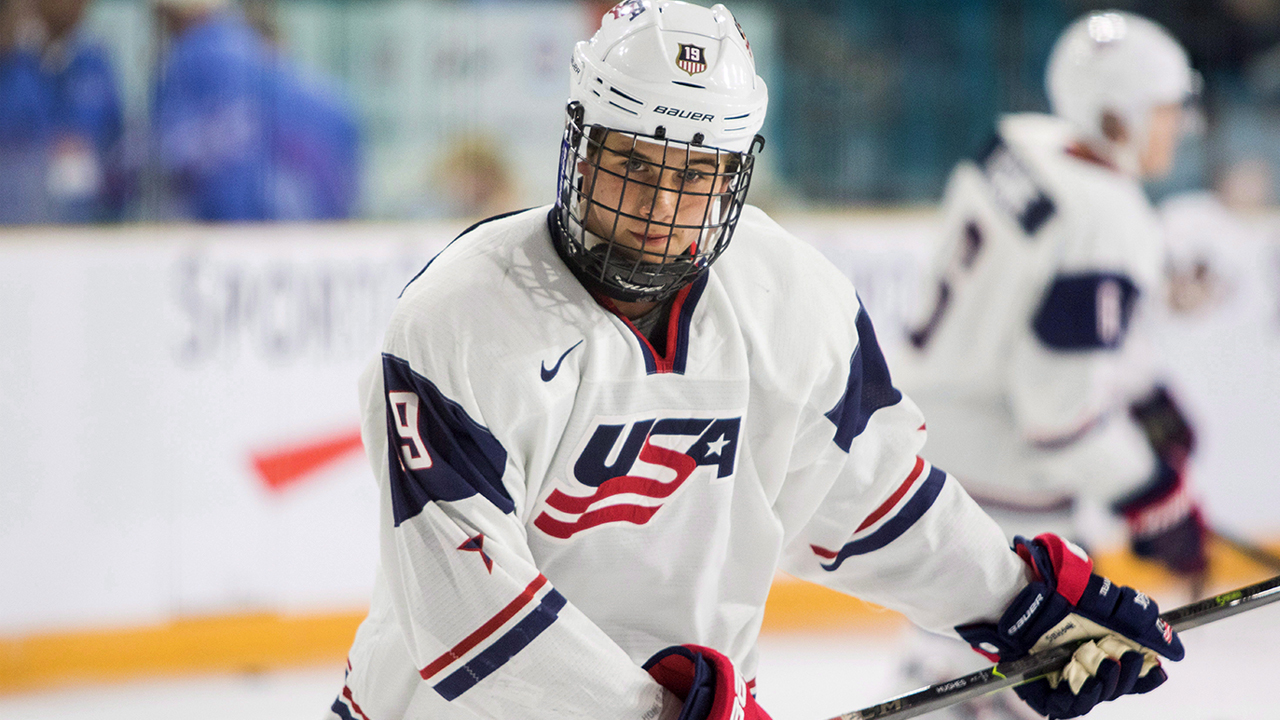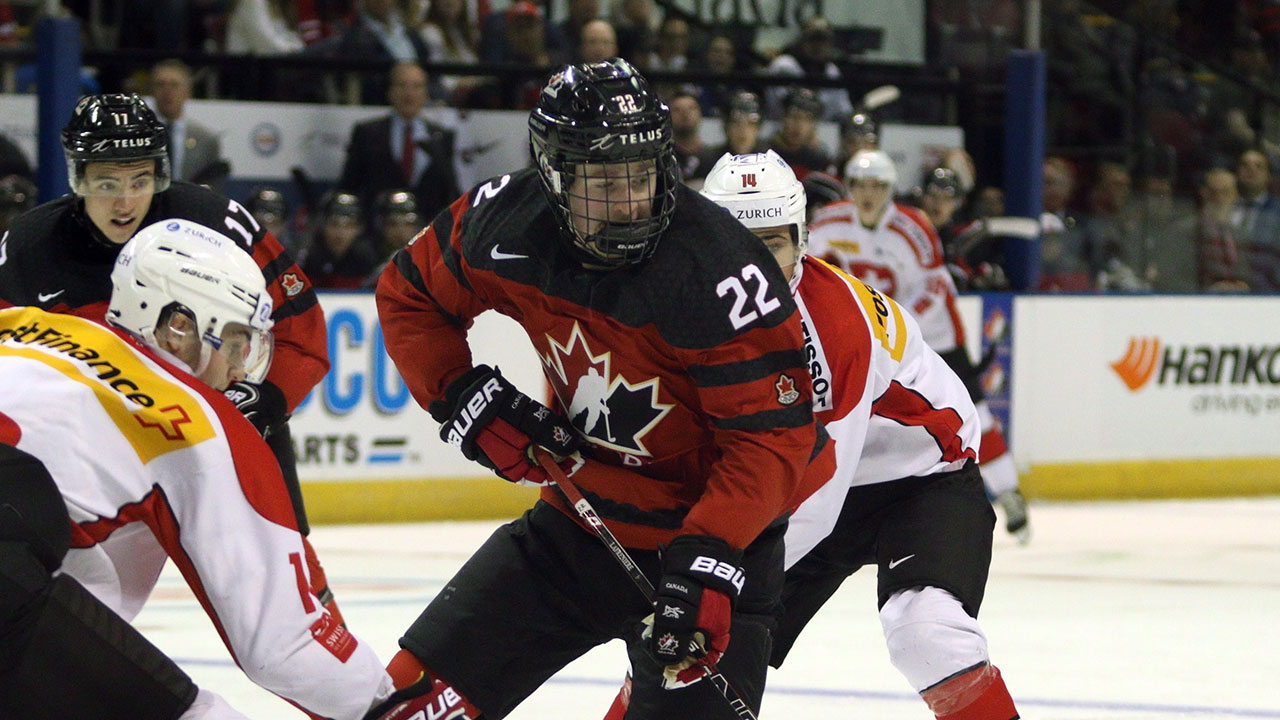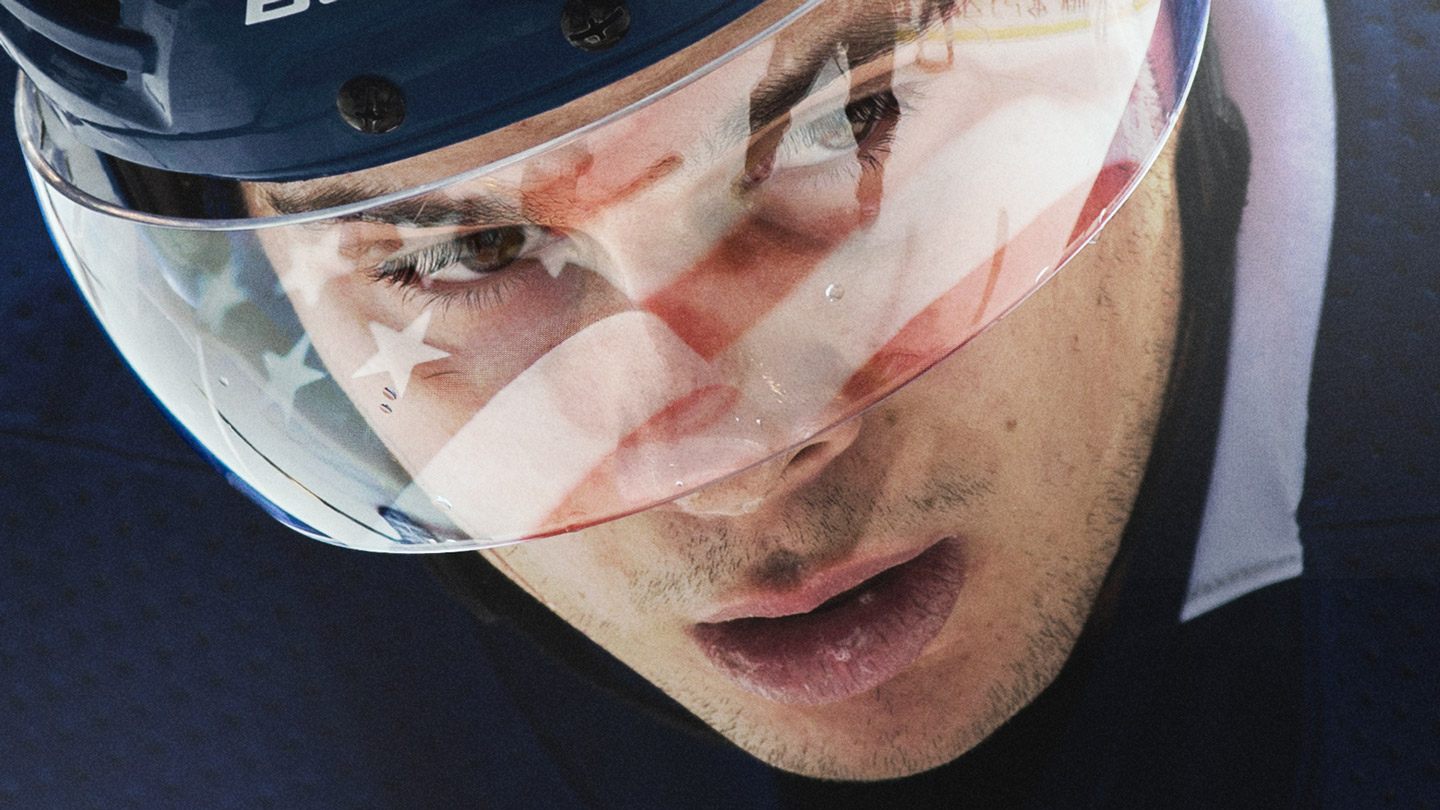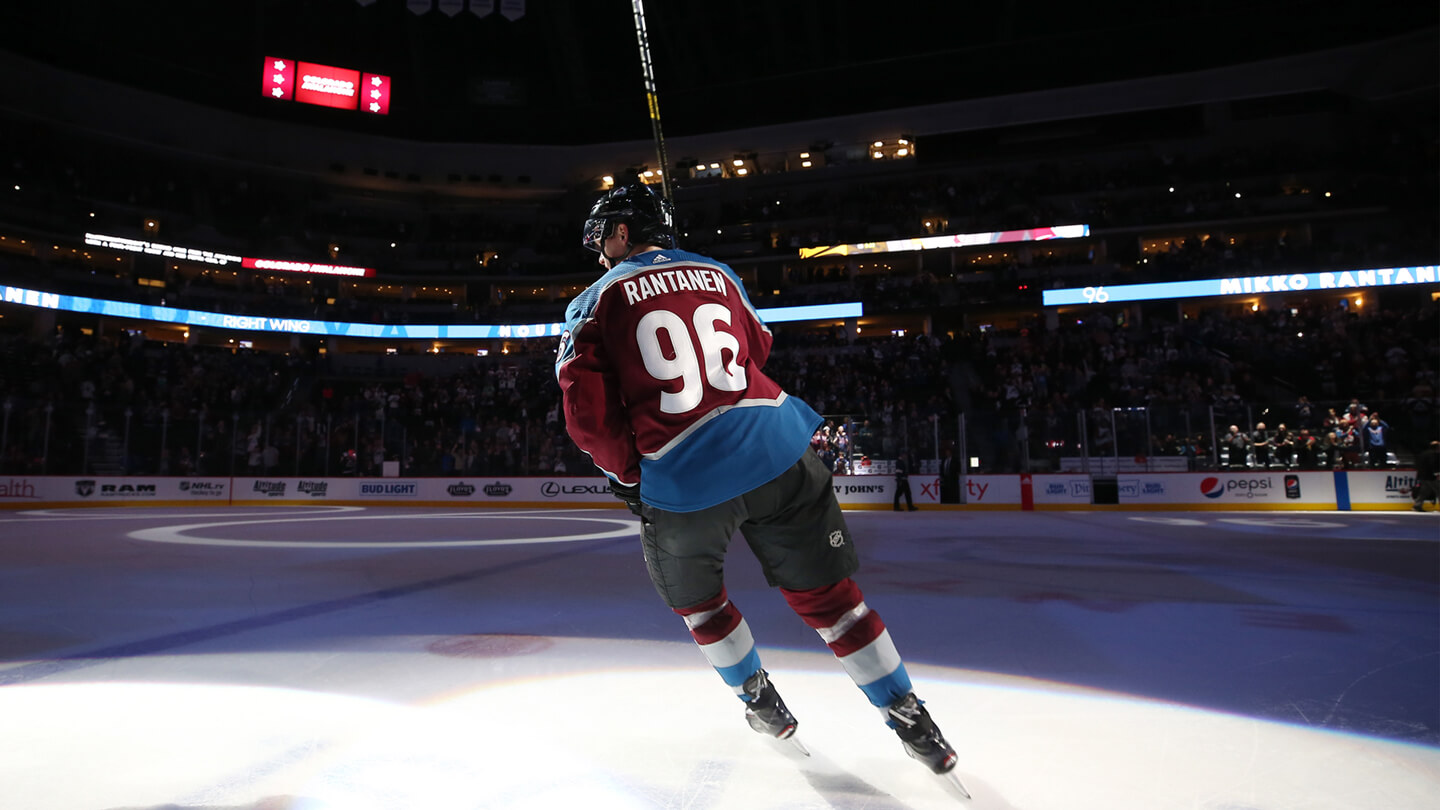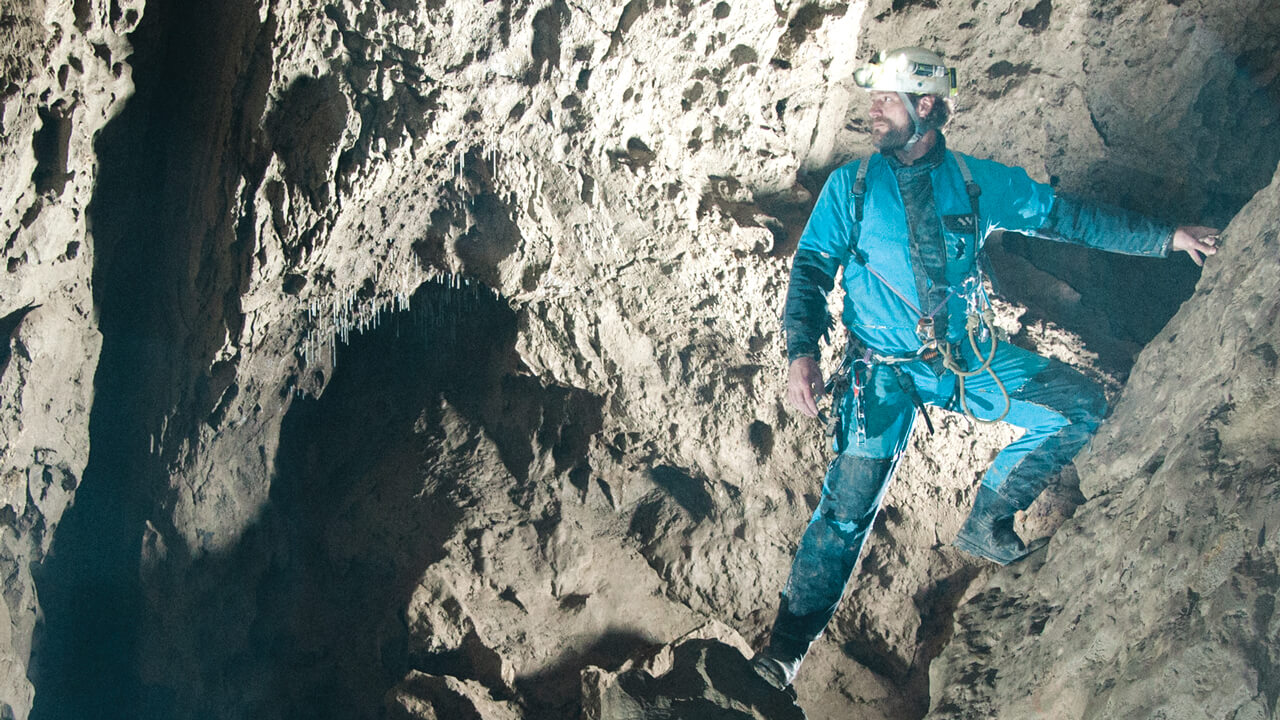NHL scouts lining the rail in back of the seats at USA Hockey Arena is pro forma. Every organization has a staffer based in the Detroit area. It’s a hub, offering easy access to NHL, AHL, NCAA and CHL games on any given night. The calendar is crowded with chances to check out talent waxing or waning, but the stop everyone makes is the home of the USA Hockey National Team Development Program, the NTDP for short.
Outside international tournaments, the NTDP’s under-18 squad faces a schedule of exhibitions against teams from the USHL and NCAA. These matchups see the U18s, the draft-eligible kids, either punching up a weight class against a lot of 19- and 20-year-olds in the USHL, or punching way, way up against collegians who might be four or five years older. On this December Saturday night, they’re facing the Waterloo Black Hawks, traditionally one of the stronger USHL franchises, and one that features a couple of decent, older European prospects — a Russian forward, Vladislav Firstov, who might squeeze into the first round, and a goaltender, Jared Moe, who was drafted in the sixth a couple of years ago by the Winnipeg Jets. The Black Hawks know they have a chance to get seen by scouts when they come to Plymouth but they also know they’re bit players here. The scouts are here to see the U18s, knowing that six or seven or even more will play in the NHL. And, of course, they’re here to watch — and even marvel at — Jack Hughes, an impossibly boyish looking 17-year-old around whom an NHL franchise will be built starting, oh, seconds after the Draft Lottery.
Ask Hughes to write his own thumbnail scouting profile and he comes back with this: “I’m a fun player to watch. I’m exciting. I’m high skilled. The big thing is I just want to win. Lots of guys have skills. My internal motor, my internal drive is what separates me. I like to think I’m a complete player.”
He also clearly has a gift for understatement.
Right from the opening faceoff, it’s plain that Hughes is in one category of prospects and everyone else on the ice is in another — it doesn’t take a professional eye to pick it out. It’s like watching a video with nine skaters running at normal speed and another, the one wearing No. 6 and the captain’s ‘C’, at 1.25 or 1.50. He’s in constant motion and it seems with every turn, sharp or wide, he somehow accelerates. He cites his “motor” or “drive” but the pros inevitably talk about his “steering” and “handling.”
“Hughes’s speed blows you away but it’s his edges that are really incredible — as good as anybody at any level,” says one scout, who is seeing the U18s for the eighth time this season and Hughes for what he estimates to be the 30th time over the past 15 months.
It’s not just the speed that makes him so dangerous. No, it’s the fact that he doesn’t leave his vision or any of his audacious puck skills in his wake. On a shift four minutes in, Hughes comes down the right side of the ice against a Waterloo defenceman giving a big cushion with his stick extended, a situation that looks like a simple one-on-one lock-up. Out of this seemingly harmless setup, with no wind-up and not even a glance, Hughes wires a shot that Hawks goalie Jared Moe only hears carom off the crossbar behind him as it barely stays out of the net. In the same situation later in the period, Hughes sends a cross-ice pass through traffic that only he and his winger, Cole Caulfield, anticipate. “Whatever Jack can do standing still he can do full speed,” says Caulfield, himself a projected first-rounder. “He just forces you to keep up and be aware.”
Up on the rail, the scouts shake their heads. Detroit general manager Ken Holland talks animatedly with his staff. Hughes wouldn’t fix everything that ails Holland’s Red Wings but his arrival would be the catalyst for a turnaround. Says one scout with another team almost certain to be in the lottery based on early season form: “You can’t help but project him into your lineup. He’s the one player [in this class] who changes everything with your franchise for five or 10 years. You’re banking information for everyone on the ice but you’re also only human. At some point you’re thinking, ‘What could he do for us?’”
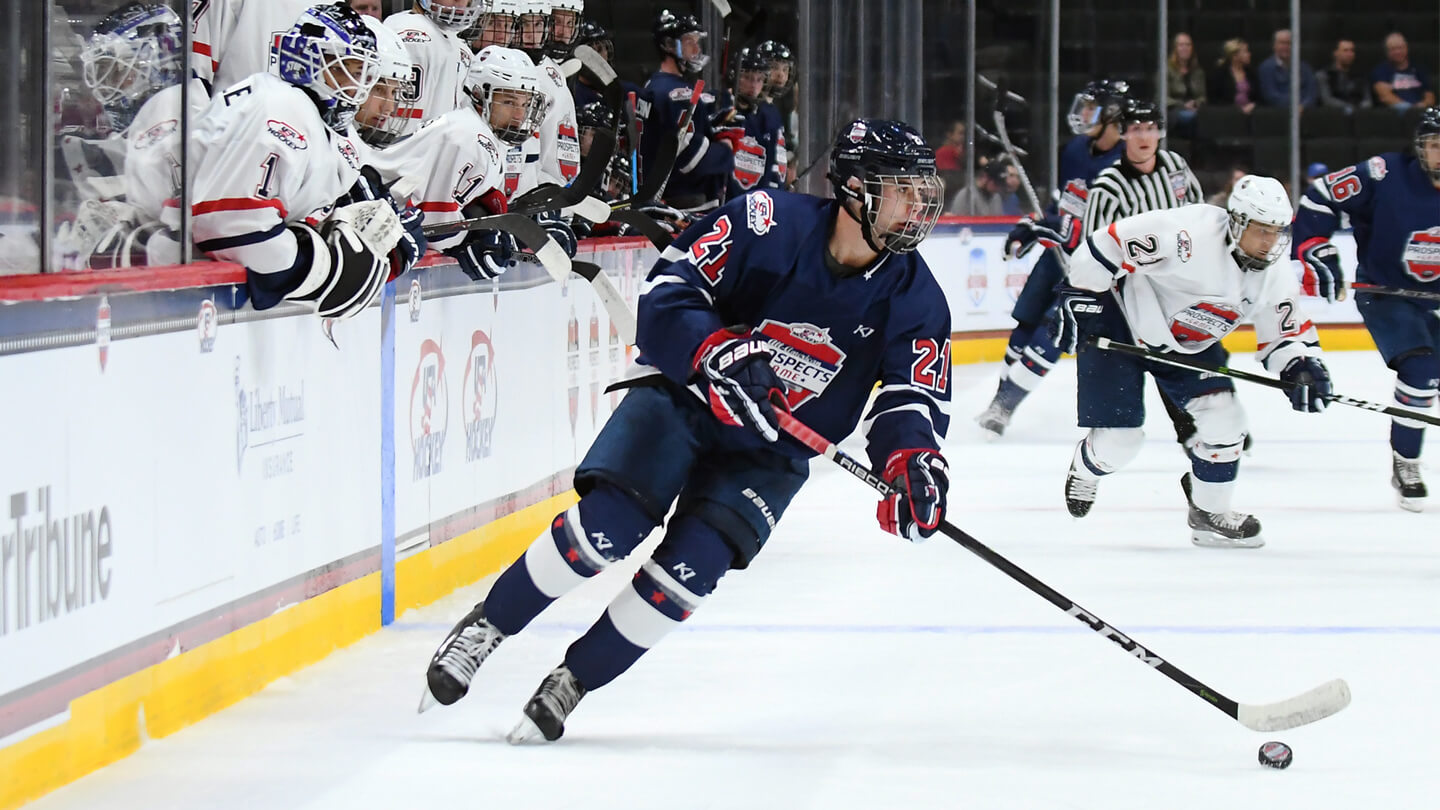
It’s not simply that 2001 was a very good year for the USA Hockey program, but rather that it still is today.
Around Plymouth, teams are referred to by birth years; thus the current U18s are the 2001s. And no one associated with the program nor anyone who tracks it professionally can call it “a very good year” and leave it at that. “It’s their best group ever,” says one veteran NHL scout. “They really haven’t had anything else like this, and they’ve had a lot of other teams that won the under-18s [world championships].” In fact, the U.S. has won the tournament 10 times, as much as the rest of the hockey world combined.
The talk about this team isn’t hype. A fair measure of the 2001s’ quality was their performance in the USHL last season. The program’s under-17 teams play a full schedule there and, understandably, usually struggle to keep up. With three future first-round NHL draft picks and a bunch of seconds and thirds, the 1998s won only six out of 34 games. The previous group, the ’97s, was considered a powerhouse and featured eight eventual first-rounders, including Auston Matthews, Brady Tkachuk and Charlie McAvoy; they managed to win 11 of 34.
Last winter, the 2001s went 19-15 against the USHL and only had their captain, Hughes, for nine of those games. They won the World Under-17 Hockey Challenge and went undefeated in their age group in international play. Hughes was unavailable to the 2001s because he’d been called up to the under-18 team. “It was just a gold mine for me getting called up,” he says.
Eventually, four other 2001s were called up to the under-18 team in Russia last year — again, unprecedented stuff. The U.S. team went to the final but fell a couple of goals short; led by Jesperi Kotkaniemi, Finland edged the Americans 3–2. Officials passed over Kotkaniemi, who’s impressing with the Canadiens this season, and his Finnish teammates for MVP honours; instead they gave the award to Hughes, who led the tournament in scoring.
Hughes and the rest of the 2001s have been just as impressive this season. In their first big test, the Five Nations Tournament, they outscored opponents 24–7 in four games. Hughes showed the way with six goals and 10 assists. He didn’t simply rack up points in blowouts, either. Against the Czechs, the U.S. led 2–1 with less than 10 minutes to go in what hardly looked like a sure thing. At that point, Hughes took over, scoring two goals, his second and third of the game, half a minute apart. He wound up adding two assists to the hat trick, all at even strength, in a 5–2 victory.
For Dan Hinote, who joined the NTDP this season as a full-time associate coach after stints as an assistant coach and scout with the Columbus Blue Jackets, the Five Nations was his first chance to see Hughes skating against players in his birth year — to that point, Hinote had only seen him against USHL and NCAA teams. Hinote says that Hughes’s performance against the Czechs evoked the Hockey Hall of Famers the coach played with on Colorado’s Stanley Cup winners in, yes, the year of the phenom’s birth. “Certain players have that knack of delivering in crucial moments, a look in their eye that says, ‘I got this one’ when it’s all on the line,” Hinote says. “I saw it with Chris Drury. I saw it with Sakic and Forsberg. Lots of guys who score 90, 100 points don’t have it. Jack does.”
The Five Nations cemented Hughes’s place atop NHL Central Scouting Service’s mid-term ranking, which will be released in mid-January. In fact, look for NTDP players to crowd the top 20 North American skaters; six others will likely be joining their captain. And along with that, the NTDP’s Spencer Knight is a lock to be the top-ranked North American goaltender. Consider: In the CSS’s pre-season players-to-watch list, eight of the U.S. 2001s were ranked as probable first-rounders compared to 11 across the entire CHL.
Still, the team’s excellence and depth is bound to be lost in the buzz around Hughes this spring. He is as certain to be the first overall pick as Sidney Crosby and Connor McDavid were. The only debate is one that will take years to play out: Will he be the best ever to come out of the NTDP?
On that score, his play at the under-20s in Victoria and Vancouver will be measured against the past performances turned in by Patrick Kane, Jack Eichel and Auston Matthews in their respective draft years. For what it’s worth, all were late birthdays and thus did not go directly into the draft from the NTDP — Kane through the London Knights, Eichel through Boston University and Matthews through the Swiss pro league. And none of them came away from the under-20s with a gold.
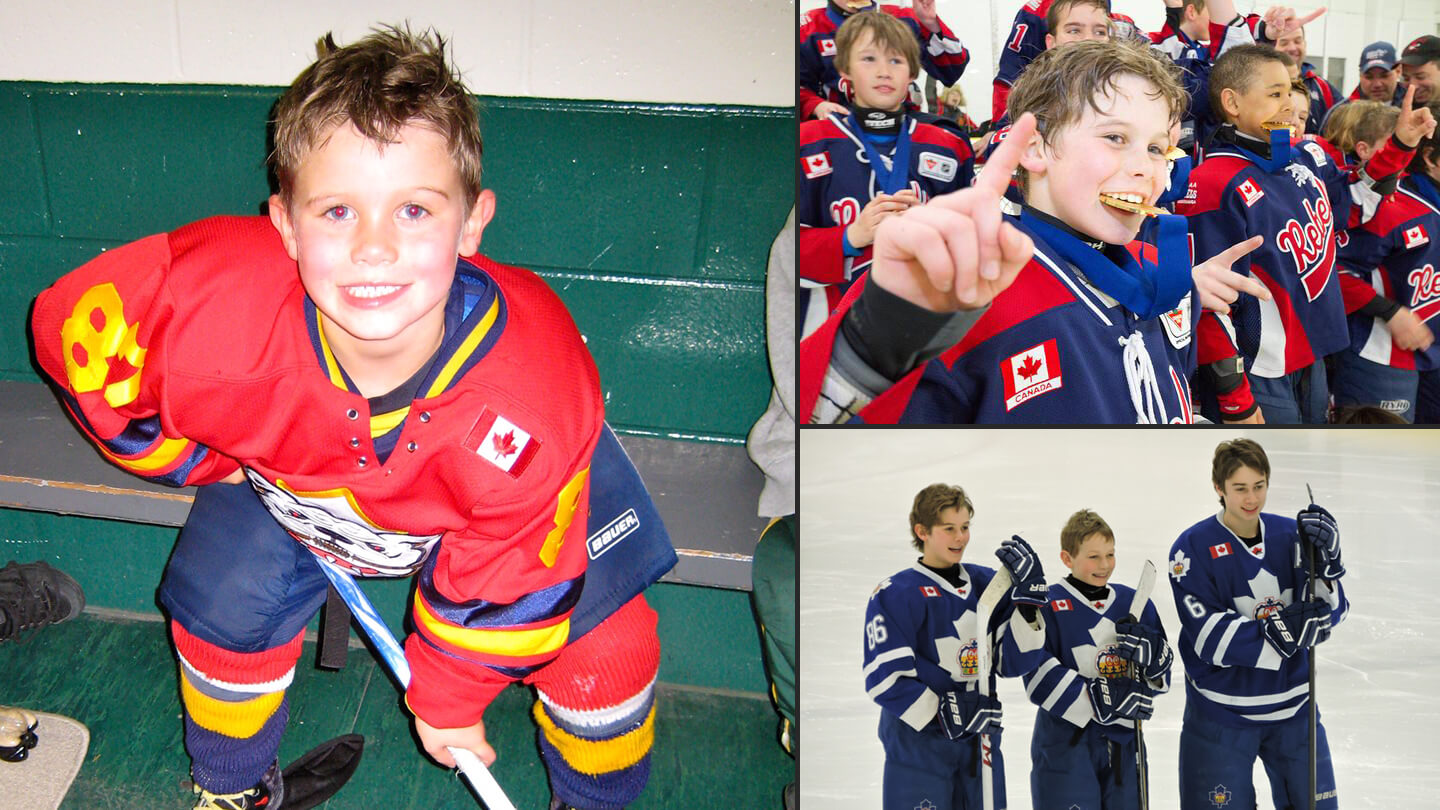
Jack Hughes’s birth certificate lists his D.O.B. as May 14, 2001, and was issued in Orange County, Florida. He’s not really a Florida kid per se; that’s just where his father happened to be working in the late ’90s and early ’00s. Twelve days after the birth of his second son, Jim Hughes coached the Orlando Solar Bears to a series-clinching win over the Chicago Wolves in what turned out to be the last International Hockey League game ever played. (Most of the IHL teams, though not Orlando, merged with the AHL.) So, in one sense, Jack Hughes was born into hockey, not just the game but also the business of the game. All that was missing was a puck and an entry-level contract in the incubator.
Ellen Weinberg-Hughes knows the game as well as her husband. Jim played collegiate hockey at Providence and she played at the University of New Hampshire — she had gone to UNH on a soccer scholarship, walked on with the hockey team in the winter and wound up as team captain in her senior year. Jim had a brief pro career but Ellen, born in St. Louis and raised in Dallas, made it even farther in the game, playing for the U.S. national team in the early ’90s. Ellen held out hope the IOC would approve women’s hockey in time for the Olympics in Lillehammer in 1994 and still hoped to make the team that would play in Nagano but a blown-out knee effectively ended her competitive career — if you don’t count skating with her sons.
Jim’s coaching career took him to an assistant’s job with the Boston Bruins and then a job behind the bench with Los Angeles’s AHL affiliate in Manchester, N.H. “Manchester’s where I started skating, age three or four on outdoor rinks, and fell in love with the game,” Jack says. Those sessions included his brother, Quinn, who’s two years older, their father, when he was free from work, and their mother, when she was untethered from youngest son Luke, who came along two seasons, uh, years after Jack.
The Hughes boys’ hockey life went from saturation to full immersion when Jim took a job as an assistant with the Marlies, Toronto’s AHL affiliate, in 2006. The family settled in the Lorne Park neighbourhood in Mississauga and immediately thereafter Ellen embarked on a schedule of getting her sons to the arenas — she took in as many games as possible but, like a true hockey-industry professional, she takes pride in the fact that she never actually bothered watching a practice. Otherwise, though, her dedication knew no limits. “Inevitably the three boys had three different tournaments in three different arenas,” Ellen says. “We had a great support network of families of the boys’ teammates who helped us out. Sometimes one of the boys would sleep over at a teammate’s home for the whole weekend.”

When the boys weren’t with their teams, they’d be in the street playing ball hockey; or skating at Wedgewood Park on an outdoor tennis court that was flooded, weather permitting; or at Marlies or Leafs games when Jim could score tickets; or, when all else failed and schoolwork was taken care of, watching NHL games at home. “Ellen is a master planner,” Jim says. “When I was coaching and when I moved to the Leafs’ player development job [two seasons later], I had to rove around and somehow she got the boys where they had to go. And she’d get on the ice with them.”
Maybe someday Wedgewood Park will be memorialized in Jack’s name or the Hughes family’s or even Ellen’s for valour in hockey parenting, but the boys referred to it as ODR, the outdoor rink. Though Jack will celebrate his 18th birthday sometime around the NHL Combine, a few stories about the Hugheses have already entered the media lore — among them Quinn getting distracted in class, staring out a window and spying Jack skating on a frozen baseball diamond outside Christ the King grade school. “We had different lunches, so Jack would be out there and I’d want to be out there with him,” Quinn says.
A skilled if smallish defenceman, Quinn was an elite talent — he would go on to star at the NTDP and wind up as a first-round pick, seventh overall, of the Vancouver Canucks in 2017 — and Luke likewise starred on the blue line for his teams, but Jim Hughes understood that his middle son was a player apart. “You could see it in Jack at a younger age,” Jim says. “He was just so fluid and so impactful, always playing up a year. He was able to dominate as an under-ager in one of top minor-hockey markets in the world. You could suspect that he’d have somewhat of a bright future.”
It seems that Jack’s tendency to understate is a learned trait.
Jack’s talent wasn’t lost on his older brother, either. Quinn describes Jack as his “best friend” and even his “biggest influence.” While that might make him sound like Jack’s biggest fan, Quinn also evinces protectiveness. “When Jack was [playing up] in bantam and I was with the Marlboros minor-midget team, we called up Jack for a game, so he was on the ice with guys two years older than him,” Quinn says. “He was so much smaller, so I worried about him. He ended up scoring a goal and two assists that game. He figured it out.”
Jack Hughes had skills like no other kid born in 2001. He also had an entrée into professional hockey unlike anyone short of the little brother of an NHL star. For a stretch the Hughes family billeted a teenaged William Nylander. Jack’s coach with the Marlboros 2000s was Dan Brown, father of Leafs winger Connor Brown, who’d play on an outdoor sheet with the Hughes boys when he was trying to win a place in the Leafs’ lineup. “I don’t know if being around William or Connor or others made [the league] seem accessible,” Jack says. “Every 12-year-old kid thinks he’s going to play in NHL. I don’t think you’re playing hockey [at that age] and not saying you’ll play in the NHL, whether you’re close to NHL players or not. But I was really lucky to meet players like that and to learn from them.”
The brothers saw all levels of the game from the inside — occasionally Jim Hughes would take one of them on a working road trip to major-junior or NCAA games. Every summer he’d take one of them to Lake Placid for the USA Hockey under-20 development camp. He says his sons came away with an education that went beyond the game. “The boys would be around Brian Burke or Dave Nonis or John Ferguson and they learned how to speak to adults,” he says. “They learned how to listen and be respectful, which really comes across when they’re at combines or in professional settings.”
And that comfort level outside his peer group comes across in his sessions with the media. Neither notepad nor microphone rattle him. As precocious as any of his skills on the ice is his nonchalance in the spotlight. “I’ve talked to reporters a fair bit for a while now,” Jack says. “I knew that this was going to be a part of it and that there’s going to be a lot more [in the pros]. I’ve seen it before and I’m ready for it.”
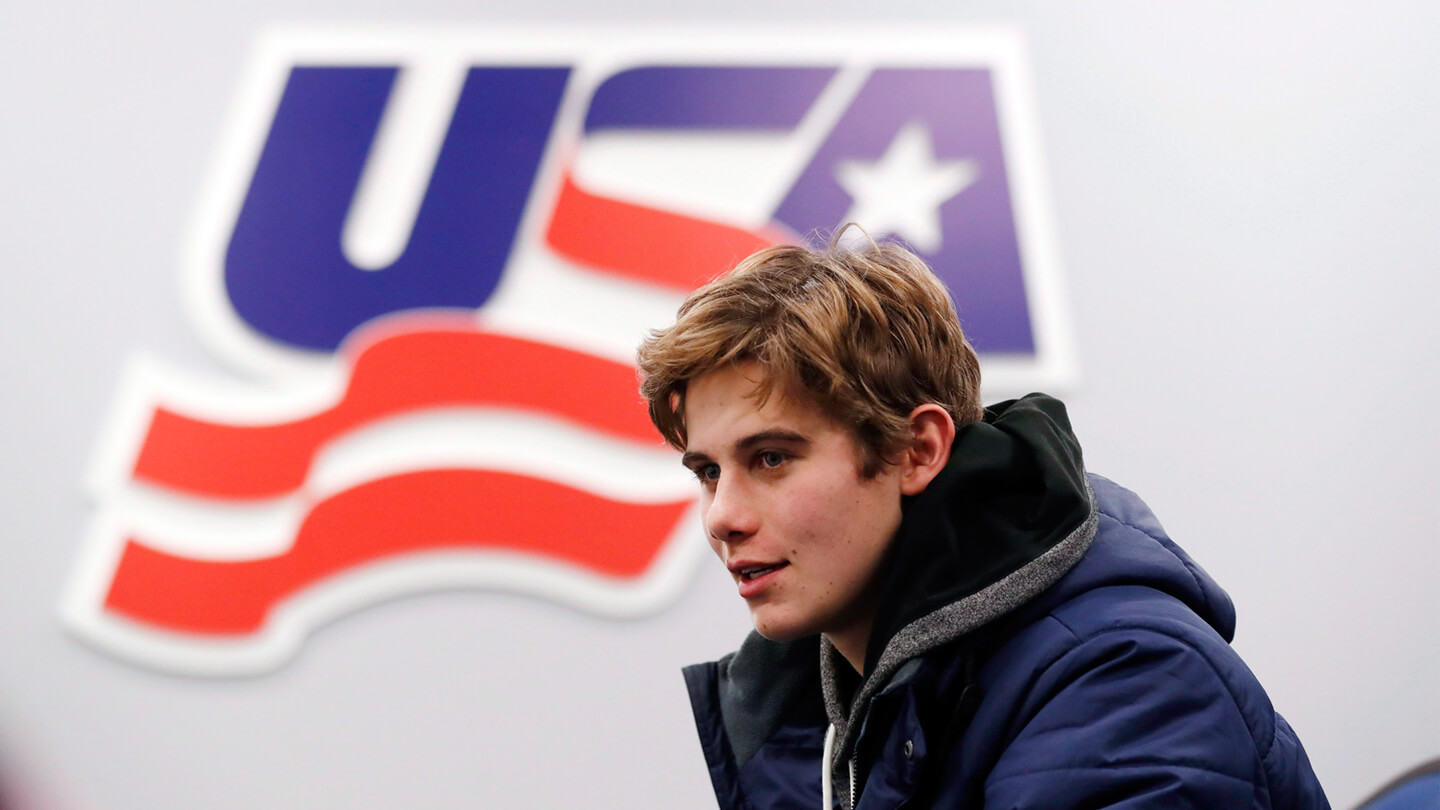
After Quinn Hughes’s minor-midget season wrapped in the spring of 2015, he had a choice of casting his lot with the Ontario Hockey League or trying out for a spot with the NTDP’s under-17 team. The Sarnia Sting selected him in the third round but by then he was set on the USA Hockey program. Jim brought Jack down to visit Quinn in Plymouth that fall and it proved to be a revelation — for Jack in the end but first for those in the offices of USA Hockey.
It started with a buzz around the arena. “It was one of my first days in the program,” says John Wroblewski, the coach of the NTDP’s 2001 team. “Someone in the office told me Quinn’s brother was going to skate with team. I knew nothing about Jack. I went down to the rink and that day he was the best player on the ice with the best players in the country who were two years older than him. Jack was tiny, so small, so weak. At the same time, they couldn’t knock him off the puck. He found ways to get separation. He could draw defenders in and then distribute the puck. He was a really special player.”
Jack came away impressed with the program on and off the ice. “I skated twice with Quinn and the practices were unbelievable, so uptempo, all-skill workouts, all about getting better. I liked the life away from the arena, too. I went back to the house where Quinn was billeting with Brady Tkachuk. I saw that this was a place where you’d make lifelong friends, just a really positive place. I could tell I’d be comfortable here.”
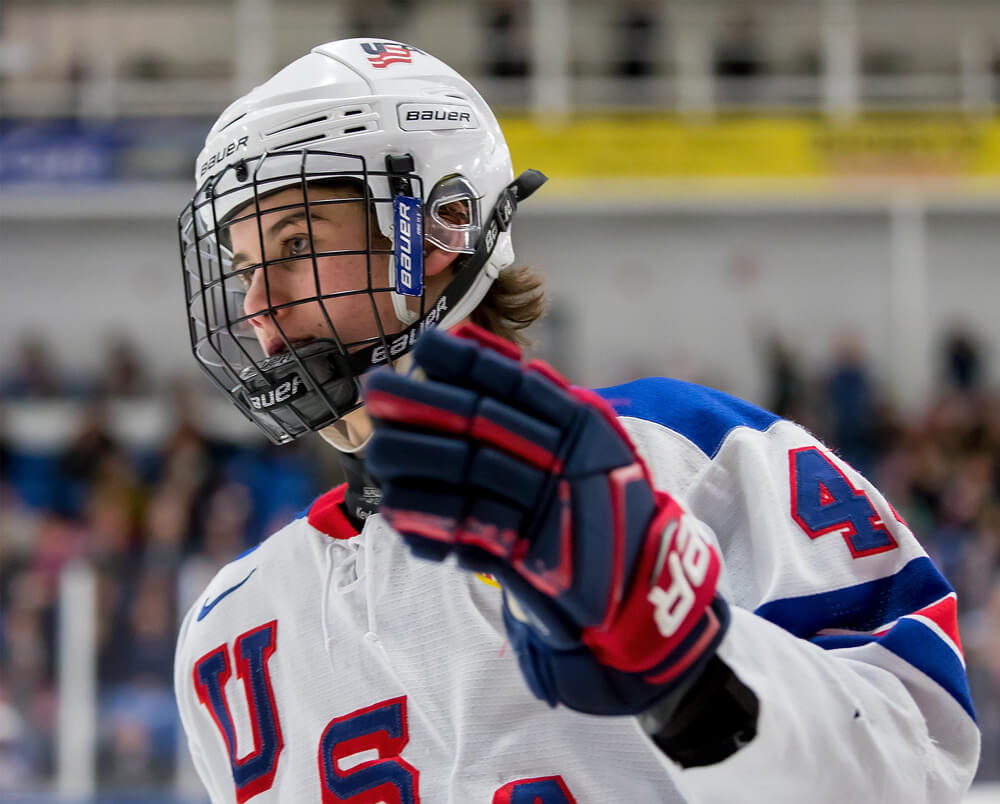
At that point, though, Jack Hughes was two years away from the NTDP’s under-17 program. Bantam-aged, he was playing for the Marlboros’ minor-midget team and another option was hanging out there for the 2016–17 season: exceptional-player status. If you’re looking for comparables to Hughes, John Tavares and Connor McDavid are a good place to start. Both are players who blossomed with early entry to the junior ranks; kids who at 15 could lap 18- and 19-year-olds. Others had gained early entry — Aaron Ekblad (a hit) and Sean Day (a miss) — but they were granted exceptional-player status in large part because they were physically mature, almost too big and strong to play in their own age group.
From Jack’s vantage point and from his family’s, a second season of minor-midget seemed like it would be a waste — playing with 2001 birthdays when he’d played all along with 2000s, when he had impressed with Quinn’s elite group of ’99s in Plymouth. “So we applied [for exceptional-player status] — I’ll openly admit that,” Jim Hughes says. “We went through process. Jack did all the paperwork. Jack did the interviews. I remember we were planning on taking a visit to Guelph on the Friday — the Storm owned the first pick in the draft — and then late Thursday I got a call to tell us that the league was denying Jack exceptional status. I don’t know why. Never got an explanation.”
Pat Brisson, the CAA agent whose client list is topped by Sidney Crosby, had first met the Hughes family when his son’s Los Angeles atom team played against Jack’s Mississauga Rebels at the Brick Invitational tournament in Calgary — Brisson’s wife, Kim Hughes (no relation), made sure their son tracked down Jack for the post-game sweater exchange. When the OHL decided to deny Jack’s exceptional-status application, Brisson told the family not to worry. “What’s the rush, really?” he says today. “I told them that Sidney didn’t get exceptional status and it didn’t hurt him. It’s a long game. It’s not how fast it comes together. It’s how well it comes together.”
Today, Jim sees the league’s decision as a blessing. “The next year, his second in minor midget, Jack had 165 points and it really did so much for his game,” Jim says. “Developmentally, sometimes it’s good to slow the process. That season allowed him to take ownership of his situation and he hasn’t looked back since.”
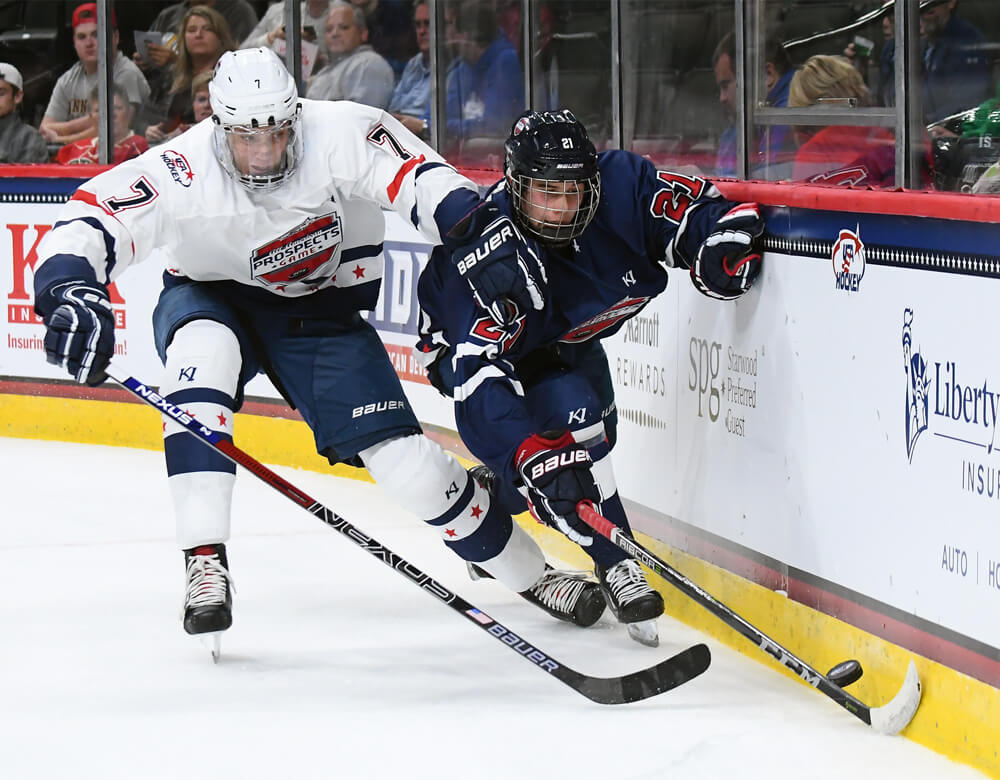
Jack made the decision to commit to the NTDP days before the 2017 OHL draft — “I knew this would be best for my game and I’d be happiest here,” he says — and the whole family moved with him from Mississauga to Michigan. The Hughes are under the same roof… well, sometimes. They’re schedules still keep them on the run. Quinn’s in his sophomore year at the University of Michigan in nearby Ann Arbor. Ellen has to drive Luke to commitments with his minor-midget team in the Little Caesars program in downtown Detroit, a good half-hour commute. Jim left the Leafs organization and signed on as a player-development consultant with CAA and that puts him on the road a fair bit. And then there’s the phenom.
Jack Hughes will tell you that his game has grown leaps and bounds in his 16 months or so in Plymouth and that he thrives with the workload. It’s hard to imagine a more demanding schedule and it’s one that every teenager at the NTDP follows. Jack is out the door at 6:15 a.m. and off to Plymouth-Canton Educational Park, a high-school with 6,000 students, among them all the players on USA Hockey’s under-18 and under-17 teams.
By the early afternoon, with classes done, he and the team are on the ice at USA Hockey Arena — after the first 60 minutes of practice, the team walks through a tunnel to a second pad, thus not having to wait for the Zamboni to flood the rink. Practice runs a full two hours and it’s high-tempo. John Wroblewski says he hasn’t run a five-on-five drill all week, going four-on-four or three-on-three and often breaking into two groups playing cross-ice at either end, the better to keep everyone engaged, the better to develop players’ skills with the puck on their sticks.
Players lift three times or four times a week under the direction of the program’s strength coach. They check in with the academic advisor on staff. They attend team or individual sessions and maybe drop in on the coaches — a couple of days before the game against Waterloo, Hughes dropped in to watch video with Wroblewski and Hinote. “That’s not out of the ordinary at all,” Wroblewski says. “Jack soaks up coaching. Every player who thinks there isn’t room for improvement is going to flatline. Look at Auston Matthews — he scored all those goals last year and then spent a summer working on making his shot better. What we talked to Jack about was getting lost on the ice — we showed him video of teams sending two or three guys after him, trying to take him off his game or take him out. We’re working on him getting lost in fray, being the 10th guy away from the puck, taking inventory on the ice, and not being the focal point of attention with the puck on his stick. We broke down video of Kane, Marner, Gaudreau and Barzal to show him how they’ll get lost on the ice and let the puck go through someone else. He’s a real student of the game. He watches video here and I know that when he gets home, he’s breaking it down even more.”
By the time he makes his way back to the Hughes home in Canton, Jack has been on the run for a full 12 hours. He eats a dinner per the schedule from a nutritionist. After dinner he does his homework and if the stars line up, has an hour at liberty. He’s in bed at 9:30. Though living at home, he follows the schedule laid out by the NTDP staff for all players. There is a curfew but it would seem a miracle if anyone could stay up late enough to break it.
Hughes says he thought about trying to qualify for the NCAA this season, cramming two years of academics into one. Others have made the jump directly from the under-17s to the collegiate ranks, most notably Noah Hanifin of the Calgary Flames and Zach Werenski of the Columbus Blue Jackets. If he had gone that way, Jack might have had an opportunity to play with Quinn at Michigan, but how he could squeeze more into his overflowing days is hard to imagine. With the U17s playing a full USHL schedule, the team had to abide by league travel rules so as not to gain any advantage — as a result, at the end of a week of exertions, the teenagers often had to board buses for, say, a 17-hour overnight ride to Omaha or a marathon trek for weekend games in Iowa.
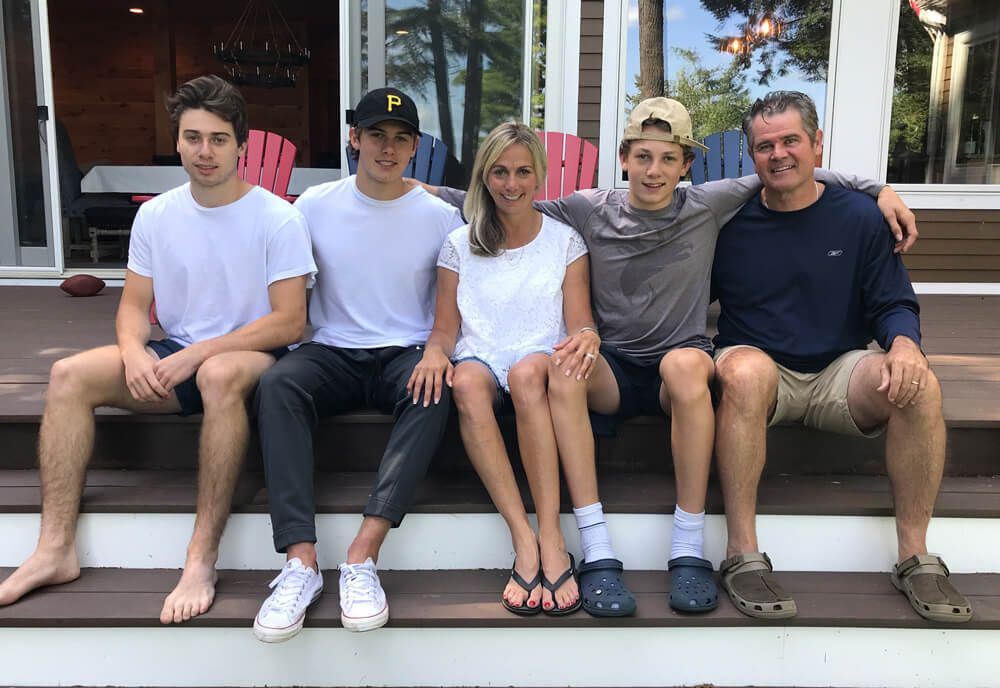
It might seem to be trial by ordeal, but Jim Hughes calls the NTDP “one of the best development programs in any sport.” Worth considering: As noted earlier, the CHL Prospects Game this season will bring together for a couple of days, barring injury, 11 projected first-rounders; every day after school Jack Hughes gets to practice against seven other teenagers whose names will be called on Friday night at the draft. “Jack raises people’s games every time on the ice but we have a bunch of drivers on this team, so every practice is like a game day,” Hinote says.
Going to an NCAA school might not have raised the bar at all — Jack and his 17-year-old teammates beat Quinn’s Michigan team 6–3 in an exhibition game in October and the 2001s’ record against Division I schools stood at 5–3 through to Jack heading off to the under-20 team’s camp. Talk to NHL scouts familiar with the program over the years and they’ll tell you that USA Hockey’s philosophy has evolved to the benefit of Hughes and the other elite teenagers. “In its first years, [the NTDP] was pointed to getting results at the end of the season, the world under-18s, and down the line, at the world juniors,” an NHL scouting director says. “It was a team-oriented, results-oriented program. Now, really since the program moved to Plymouth [in 2015], it’s become about building better players and skills development. The foundation was always there — the ratio of practices to games. But now it’s about skills and not all about the short-term returns.”
Perhaps, but for Jack Hughes over the holidays and into the new year, it will be about a handful of games, the World Junior Championship. “I’ve dreamed of playing in this tournament with my brother my whole life,” Jack says. “Odds are, I’m probably not going to get a chance to play with Quinn in the NHL. That the tournament is in Canada is just that much better. We went [to WJC games] when they were in Toronto. We even went to Montreal.”
For lottery-bound NHL teams, the world juniors will be a telling indicator of Hughes’s readiness to make an unprecedented jump directly from the NTDP to the NHL. He’s not as physically prepossessing as those he’s compared to, the first-overall picks who played in the under-20s in their draft-eligible seasons before moving on to the NHL at 18. Central Scouting lists Hughes at five-foot-10.25 and 168 pounds, and he might be even slighter. By his account and that of everyone in his camp, his physical development has tracked just like Quinn’s. “He’s a young 17 [physically] like Quinn was. But in the year and half since Quinn graduated [from the NTDP], he’s filled out a lot, so you can assume Jack will too,” Wroblewski says.
Perhaps, but in the meantime Jack avoids any bold declarations about his belief that he can play in the NHL next October, but neither has he made a commitment to an NCAA school, unlike his NTDP teammates. “It’s your dream to get to the NHL from the time you’re in minor hockey but really only in the last year did the idea of playing in the NHL someday come clear to me,” he says. Still, he exudes quiet confidence about playing in the league as soon as possible and Brisson says simply that the chances for Jack making that jump “are out there.” In his hybrid role of father and industry pro, Jim Hughes is noncommittal about a timeline for his middle son, and Jack clearly has taken his advice to heart. “I’ve taught the boys to stay in the present and don’t get too far ahead of themselves,” Jim says. “Try to be better every day and understand that nothing big has happened yet.”
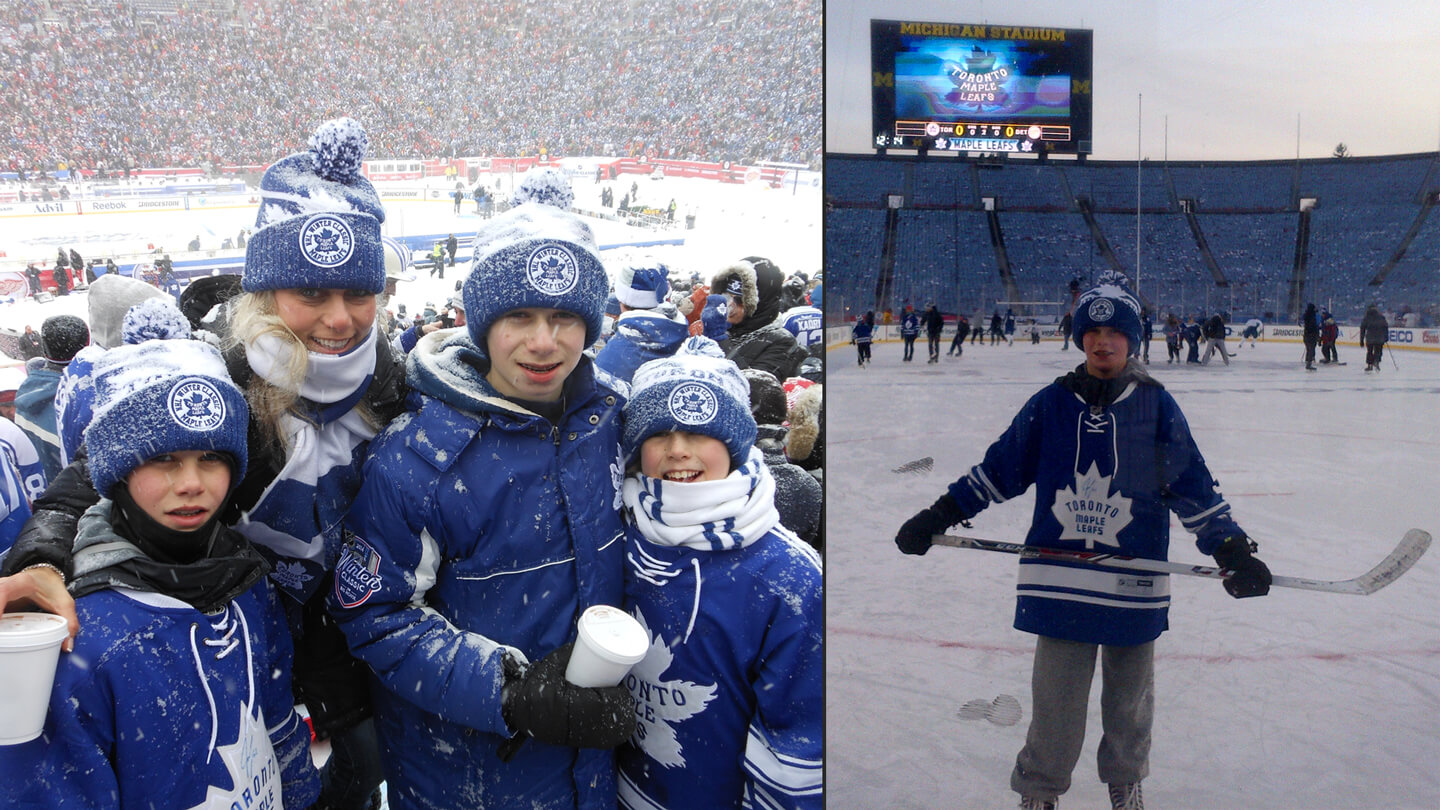
The 2001s carry a 2-0 lead late in the second period of this exhibition against Waterloo, their 24th game of the season. By the final whistle, they’ll owe a debt to their goaltenders — splitting duties at the midway point, Cameron Rowe and Spencer Knight will stop 35 of 36 shots. Hughes has done something that catches your eye every shift but scouts are of the opinion that, at this point in the season, the team is a little fatigued, still paying a price for the travel to the Five Nations and four games in five days a couple of weeks back. Says one scout: “When the team struggles you can see Jack tries to do too much. It’s not a bad thing. It’s something he’ll figure out.”
Through 30 minutes, the Black Hawks are becoming less discreet with their attempts to jab and provoke Hughes but he mostly brushes it off and doesn’t get drawn into a retaliatory penalty. He does draw a couple of Waterloo minors, though, which is per usual. Says Hinote: “With his speed and edges, I don’t see how he doesn’t draw three power plays a game in the Show, as strict as they are with their rules.”
Faster than everyone else to begin with, Hughes incredibly finds another, higher gear when, on a U18 power play, a turnover at the blue line sends a Black Hawk penalty killer off on what should have been a 120-foot breakaway — on his way to break up the play at about the 90-foot mark, Jack blows right past his two teammates who were back on the point. He also processes the game faster — an errant pass in his skates is kicked up to his stick without breaking stride and the puck is wired to a teammate, all in a blink. As his former Marlboros coach Dan Brown notes: “The way he can use all his skills and his vision at top speed, it’s like the clock is ticking slower for him than everyone else.”
At even strength in the last minute of the second period, Hughes tracks down a loose puck behind the Waterloo net and Black Hawks defenceman Hank Sorensen gives chase, in vain of course. Hughes looks like he’s going to pick up the puck and circle behind the net but instead he picks up Cole Caulfield in his rearview mirror. At full speed he takes a sharp turn and then throws a backhand, behind-the-back pass that hits Caulfield in stride pouring down the left side of the ice and into the space vacated by Waterloo’s over-committed defenceman. Caulfield throws the puck over to their linemate Michael Gildon who has a wide-open net. It will go down as a secondary assist for Hughes, his second of the game and 48th point of the season, but it’s as impressive as anything all night and there was plenty to impress. Three-zip for the U.S. under-18s. Waterloo will get a power play goal in the third but really don’t threaten to make it any tenser than that.
The NHL scouts pack up at the game’s end. Really, their priority at USA Hockey Arena this winter will be making the book on the seven other projected first-rounders. Cole Caulfield is under five-foot-seven but, with 21 goals in 25 games this season, he’s doing a very passable impression of Alex DeBrincat. Is Caulfield a lottery pick or did he win a lottery by getting a chance to play with Jack Hughes, or both? Scouts will deal with pressing questions about those other prospects while trying to some extent to avoid being distracted by the phenom in their midst.
The underlying ironies: As the NHL pulls ever more clearly into view for a 17-year-old who’s dreamed of making the Show, he becomes the dream for half the league.
Designed and edited by Evan Rosser

